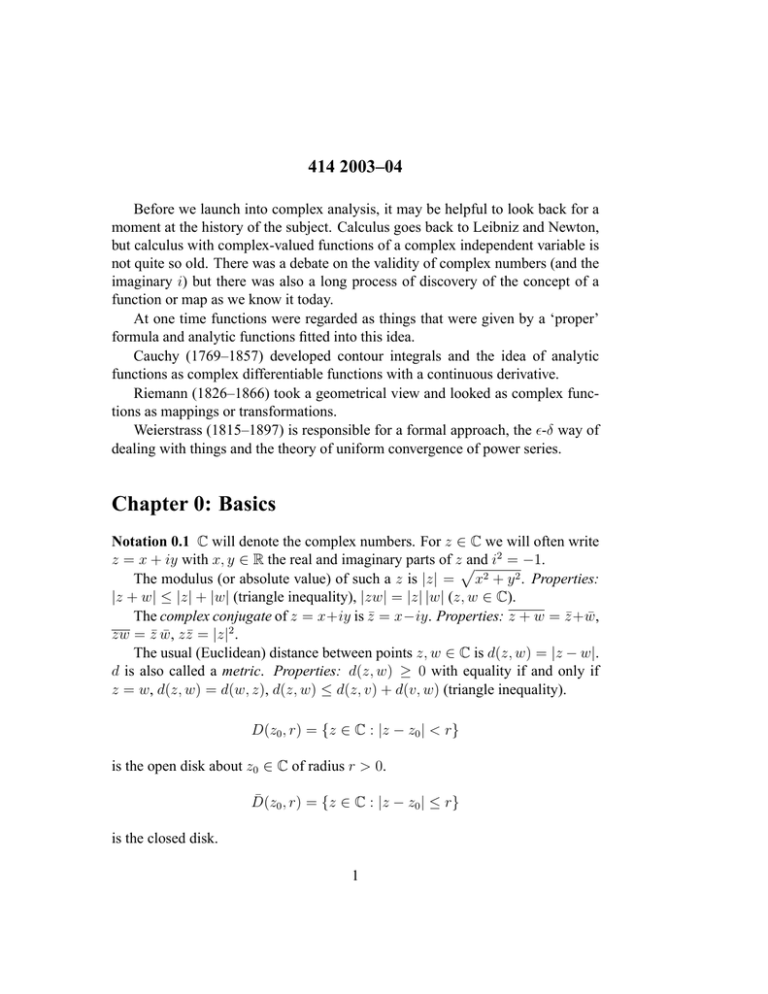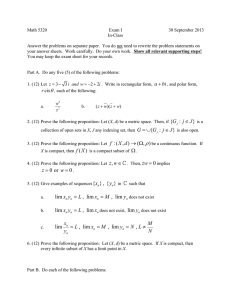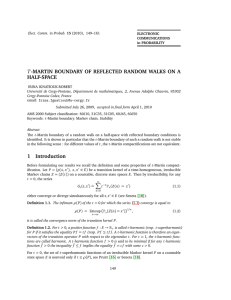414 2003–04
advertisement

414 2003–04
Before we launch into complex analysis, it may be helpful to look back for a
moment at the history of the subject. Calculus goes back to Leibniz and Newton,
but calculus with complex-valued functions of a complex independent variable is
not quite so old. There was a debate on the validity of complex numbers (and the
imaginary i) but there was also a long process of discovery of the concept of a
function or map as we know it today.
At one time functions were regarded as things that were given by a ‘proper’
formula and analytic functions fitted into this idea.
Cauchy (1769–1857) developed contour integrals and the idea of analytic
functions as complex differentiable functions with a continuous derivative.
Riemann (1826–1866) took a geometrical view and looked as complex functions as mappings or transformations.
Weierstrass (1815–1897) is responsible for a formal approach, the -δ way of
dealing with things and the theory of uniform convergence of power series.
Chapter 0: Basics
Notation 0.1 C will denote the complex numbers. For z ∈ C we will often write
z = x + iy with x, y ∈ R the real and imaginary parts of zp
and i2 = −1.
The modulus (or absolute value) of such a z is |z| = x2 + y 2 . Properties:
|z + w| ≤ |z| + |w| (triangle inequality), |zw| = |z| |w| (z, w ∈ C).
The complex conjugate of z = x+iy is z̄ = x−iy. Properties: z + w = z̄+ w̄,
zw = z̄ w̄, z z̄ = |z|2 .
The usual (Euclidean) distance between points z, w ∈ C is d(z, w) = |z − w|.
d is also called a metric. Properties: d(z, w) ≥ 0 with equality if and only if
z = w, d(z, w) = d(w, z), d(z, w) ≤ d(z, v) + d(v, w) (triangle inequality).
D(z0 , r) = {z ∈ C : |z − z0 | < r}
is the open disk about z0 ∈ C of radius r > 0.
D̄(z0 , r) = {z ∈ C : |z − z0 | ≤ r}
is the closed disk.
1
2
Chapter 0: Basics
Open and closed subsets 0.2 A set G ⊆ C is open if each z ∈ G is an interior
point of G.
A point z ∈ G is called an interior point of G if there is a disk D(z, r) ⊂ G
with r > 0.
Picture for an open
S set: G contains none of its ‘boundary’ points.
Any union G = i∈I Gi of open sets Gi ⊆ C is open (I any index set, arbitrarily large).
F ⊆ C is closed if its complement C \ F is open.
Picture for a closed set: F contains all of its ‘boundary’ points.
Note that open and closed are opposite extremes. There are plenty of sets
which are neither open nor closed. For example {x + iy : 0 ≤ x, y < 1} is
a square in the plane with some of the ‘boundary’ included and some not. It is
neither open nor closed.
S
Any intersection F = i∈I Fi of closed sets Fi ⊂ C is closed.
Finite intersection G1 ∩ G2 ∩ · · · ∩ Gn of open sets are open.
Finite unions of closed sets are closed.
Interiors and closures 0.3 For any set E ⊆ C, the interior E ◦ is the set of all its
interior points.
E ◦ = {z ∈ E : ∃r > 0 with D(z, r) ⊆ E}
is the largest open subset of C contained in E. Also
[
E ◦ = {G : G ⊆ E, G open in C}
Picture: E ◦ is E minus all its ‘boundary’ points.
The closure of E is
\
Ē = {F : F ⊂ C, E ⊂ F and F closed}
and it is the smallest closed subset of C containing E.
Picture: Ē is E with all its ‘boundary’ points added.
Properties: Ē = C \ (C \ E)◦ and E ◦ = C \ (C \ E).
414 2003–04
3
Boundary 0.4 The boundary ∂E of a set E ⊆ C is defined as ∂E = Ē \ E ◦ .
This formal definition makes the previous informal pictures into facts.
Relatively open and closed 0.5 If R ⊆ T ⊆ C is a subset of a subset T of C,
then R is called open in T (or open relative to T ) if for each z ∈ R it is possible
to find some r > 0 so that D(z, r) ∩ T ⊂ R.
Note that for each z ∈ R we have a choice
S of r = rz > 0 that depends on
z ∈ R so that D(z, rz ) ∩ T ⊂ R. Taking G = z∈R D(z, rz ) we find an open set
G ⊂ C with R = T ∩ G. This is an equivalent condition for R ⊂ T to be open in
T.
S ⊆ T is called closed in T if T \ S is open in T . Equivalently, if S = T ∩ F
for F ⊂ C closed.
Picture: S ⊂ T is closed in T contains all of its boundary points that are in
T.
This can also be used a pictorial explanation of relatively open R ⊂ T : R does
not contain any of the boundary of S = T \ R.
Connected 0.6 A subset T ⊆ C is called connected if the only subsets X ⊆ T
that are both open in T and closed in T are X = ∅ and X = T .
Equivalently, if it is not possible to decompose T = T1 ∪ T2 with T1 ∩ T2 = ∅,
T1 6= ∅, T2 6= ∅ and both T1 and T2 open in T .
Proposition 0.7 If T1 , T2 ⊆ C are each connected and T1 ∩ T2 6= ∅, then T1 ∪ T2
is connected.
More generally, if {Ti : i ∈ I}Sis a family of connected subsets Ti ⊆ C and
Ti ∩ Tj 6= ∅ for each i, j ∈ I, then i∈I Ti is connected.
Definition 0.8 If T ⊆ C is a set and z ∈ C, then the connected component of z
in T is
[
{X : X ⊆ T, z ∈ X and X connected }
Remark 0.9 We can define an equivalence relation on any set T ⊆ C by defining
z ∼ w (for z, w ∈ T ) if there is some connected X ⊆ T with both z, w ∈ X.
The connected component of a point z ∈ T is then the equivalence class of z
under this equivalence relation.
Using the general theory of equivalence relations, it follows that the connected
components of any T ⊆ C partition T . (That is, any two connected components
of T are either identical or disjoint.)
4
Chapter 0: Basics
Example 0.10
1. T = D(0, 1) ∪ D(2, 1) is not connected.
2. We will see that D(0, 1) ∪ D(2, 1) ∪ {1} is connected.
Theorem 0.11 Intervals in R are connected.
Continuity 0.12 If f : T → C is a function on a subset T ⊆ C, then f is called
continuous at a point z0 ∈ T if for each ε > 0 it is possible to find δ > 0 so that
z ∈ T, |z − z0 | < δ ⇒ |f (z) − f (z0 )| < f : T → C is called continuous if it is continuous at each point z0 ∈ T .
Proposition 0.13 If T ⊆ C and f : T → C, then f is continuous if and only if
it satisfies the following condition: for each open set U ⊂ C, its inverse image
f −1 (U ) = {z ∈ T : f (z) ∈ U } is open in T .
Proposition 0.14 If T ⊆ C, then T is connected if and only if there is no continuous function f : T → R with range the two point set {0, 1}.
Equivalently if the only continuous functions f : T → R with range f (T ) ⊂
{0, 1} are constant.
Proof. Exercise.
Theorem 0.15 If f : T → C is continuous and T ⊆ C is connected, then f (T ) =
{f (z) : z ∈ T } is connected. (Continuous images of connected sets are connected.)
Proof. Exercise. (Not so hard using the previous result.)
Path Connectedness 0.16 By a path in C, we mean a continuous function γ: I →
C from an interval I ⊆ R.
We say that a set T ⊆ C is path connected if for each pair of points z0 , z1 ∈ T
it is possible to find a path γ: [0, 1] → T in T with starting point γ(0) = z0 and
ending point γ(1) = z1 .
Proposition 0.17 Path connected subsets T ⊆ C are connected.
5
414 2003–04
Proof. If γ: [0, 1] → T is a path, then γ([0, 1) is a connected set by Theorems 0.11
and 0.15. Thus γ(0) and γ(1) belong in the same connected component of T for
any such path.
If T is path connected, this argument shows that every pair of points of T
belong in the same connected component and so there is only one connected component (or no connected components at all if T is empty). Thus T is connected.
Remark 0.18 This proposition can be used to show that discs are connected sets.
For example if z ∈ D(z0 , r) then the path γ: [0, 1] → D(z0 , r) given by γ(t) =
(1 − t)z0 + tz is a path in the disc joining z0 to z.
One can also show that D(0, 1) ∪ D(2, 1) ∪ {1} is path connected and so
connected, justifying an earlier example.
Theorem 0.19 If G ⊂ C is open and connected, then G is path connected.
Proof. Exercise.
Limits 0.20 We will find it convenient to have the idea of a punctured disc. A
punctured (open) disc is a disc D(z, r) \ {z} minus its center.
If f : T → C is a function defined on some set T ⊆ C which includes some
punctured disc D(z0 , r) \ {z0 } of positive radius about z0 ∈ C and if ` ∈ C, then
to say that the limit of f as z approaches z0 is `, or in symbols,
lim f (z) = `
z→z0
means the following:
for each > 0 it is possible to find δ > 0 so that
z ∈ C, 0 < |z − z0 | < δ ⇒ |f (z) − `| < An equivalent condition is that: for each sequence (zn )∞
n=1 in G \ {z0 } with
limn→∞ zn = z0 we have limn→∞ f (zn ) = `.
The catch is that we need ’s to define limits of sequences. To say limn→∞ wn =
` means:
for each > 0 it is possible to find N ∈ N so that
n ∈ N, n > N ⇒ |wn − `| < .
6
Chapter 0: Basics
Proposition 0.21 If G ⊂ C is open and f : G → C, then f is continuous at a
point z0 ∈ G if and only if limz→z0 f (z) = f (z0 ).
Remark 0.22 One can show that the limit of a sum is the sum of the limits (provided the individual limits make sense). More symbolically,
lim f (z) + g(z) = lim f (z) + lim g(z).
z→z0
z→z0
z→z0
Similarly
lim f (z)g(z) = ( lim f (z))( lim g(z))
z→z0
z→z0
z→z0
if both individual limits exist.
We also have the result on limits of quotients,
lim
z→z0
f (z)
limz→z0 f (z)
=
g(z)
limz→z0 g(z)
provided limz→z0 g(z) 6= 0. In short the limit of a quotient is the quotient of the
limits provided the limit in the denominator is not zero.
There is also a theorem on limits of compositions, which needs continuity. If
limz→z0 f (z) = ` and g: T → C is defined on a set T that has ` as in interior point
and if g is continuous at `, then
lim g(f (z)) = g(`).
z→z0
An important basic example of continuity is provided by polynomial functions
p(z) = an z n + an−1 z n−1 + · · · + a1 z + a0 . We have limz→z0 p(z) = p(z0 ) (for
any polynomial p and any z0 ∈ C).
Compactness 0.23 Let T ⊆ C be a subset of the complex plane. An open cover
of T is a family U of open subsets of C such that
[
T ⊆
{U : U ∈ U }
A subfamily V ⊆ U is called a subcover of U if V is also a cover of T .
T is called compact if each open cover of T has a finite subcover.
T is called bounded if there exists R ≥ 0 with T ⊆ D̄(0, R).
One way to state the Heine-Borel theorem is that a subset T ⊆ C is compact
if and only if it is both (1) closed and (2) bounded.
Continuous images of compact sets are compact: T ⊆ C compact, f : T → C
continuous implies f (T ) compact.











